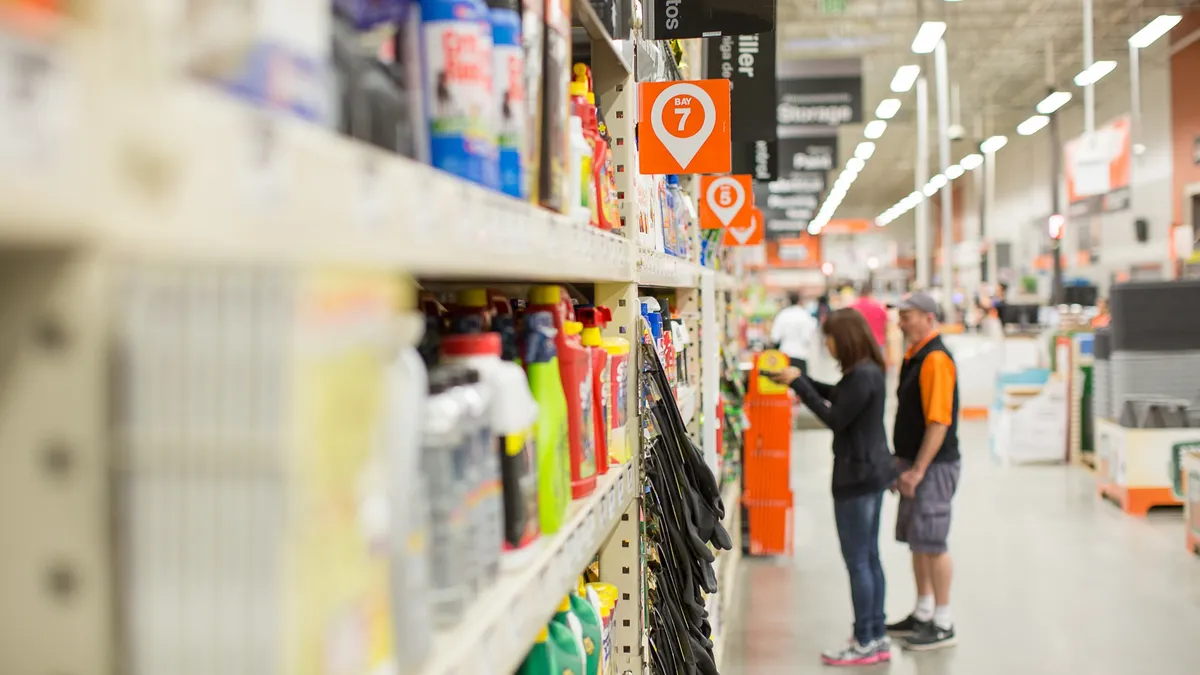As life suddenly began to revolve around the home, the home improvement category stood to benefit as consumers started to invest more into their personal spaces.
And even as vaccinations across the country ramped up and restrictions eased, these retailers continued strong sales momentum through the first quarter.
The Home Depot on Tuesday reported net sales increased 32.7% to $37.5 billion, while comparable sales rose 31%. U.S. comps rose 29.9% from last year, and all of the retailer's top 40 markets posted double-digit comps growth, according to CEO Craig Menear. Home Depot's earnings in the first quarter increased 84.6% year over year to $4.1 billion.
"Demand for home improvement remains robust, as DIY customers continue to take on home improvement projects and Pros have seen projects resume and their backlogs build after pausing this time last year," Telsey Advisory Group Senior Managing Director Joseph Feldman said in emailed comments. "These trends, together with the benefit from US stimulus checks, drove broad-based strength at Home Depot in 1Q21 and so far in May."
Outdoor and garden categories, as well as interior areas like countertops, vanities and home decor experienced "significant" growth in the quarter, executives said. The retailer also reported double-digit growth from both its Pro and DIY customers during the quarter, with Pro slightly outpacing DIY, Chief Operating Officer Ted Decker said Tuesday on a call with analysts.
"On the householder side, the number of people undertaking projects around the home continues to increase," GlobalData Managing Director Neil Saunders said in emailed comments. "There is a very clear pattern of investing in living spaces whether through full remodeling or partial decoration. The impetus for this is partly because people are still at home more than they used to be and so want to make their environments as comfortable and pleasant as possible."
Many consumers also received their stimulus checks during the first quarter, he noted, adding that the average consumer spent about 21% of their stimulus check on home-related products.
E-commerce — which experienced exponential growth across the industry since the onset of the coronavirus pandemic — grew 27% year over year at Home Depot and over 100% when compared on a two-year stacked basis.
"While we continue to see strong level of engagement across our digital platforms, we saw more of our customers return to our stores," Menear said. "Sales leveraging our digital platforms increased approximately 27% versus the first quarter last year and approximately 55% of online orders were fulfilled through a store."
In fact, visits to stores — which, having been deemed essential, have been allowed to remain open throughout the pandemic — in April increased 23.6% from the year-ago period, according to Placer.ai.
Meanwhile, Lowe's on Wednesday reported net sales grew 24.1% to $24.4 billion. Total comps grew 25.9%, above Telsey Advisory Group's estimate of 23% and FactSet's of 20.7%, while U.S. comps rose 24.4%. Net income during the period increased 73.6% to $2.3 billion, while operating income rose 63% to $3.2 billion.
But while the retailer was able to post double-digit gains against last year's significant growth, Saunders notes that this growth is beginning to show signs of slowing down. "Admittedly the slowdown is modest, but this quarter's growth was the slowest of the past year and forms part of an established trend of moderate decline. This is important because the overall market for home improvement accelerated during the first quarter, so Lowe's is bucking a trend and, despite its very nice uplifts, is losing market share," he said. "The losses may be fractional, but they are potentially an important harbinger of Lowe's ability to perform over the year ahead."
And unlike the majority of the pandemic, where Lowe's was able to outperform its larger competitor, Home Depot in the quarter outperformed, including in store traffic. Among others in the category, including Home Depot, Tractor Supply, Harbor Freight and Ace Hardware, Lowe's was the only retailer that experienced year-over-year foot traffic declines in April, down 0.2%, according to Placer.ai. However, when compared against 2019 levels, Lowe's store visits during the period increased 14.2%, while Home Depot increased 17.9%.
But Lowe's is showing signs of strength attracting Pro customers to shop with it. The retailer reported over 30% comps growth from its Pro customers, outpacing DIY comps, CEO Marvin Ellison said.
Throughout the year, Lowe's has introduced a number of initiatives geared toward the professional audience, including rolling out an augmented video chat tool last June, which allows Pros to virtually visit homeowners and clients, and launching a new store shopping experience this past April.
As consumers begin to leave their houses once again, the unprecedented growth home retailers experienced this past year may begin to slow as they direct spending to other areas, like dining out or travel. "[A]t some point, consumers will curb spending on home improvement and the growth of individual players will become much more dependent on their ability to compete with each other rather than relying on organic growth," Saunders said. "Given the evidence we have seen, Home Depot appears to be in a much more favorable position. … our contention has been that some of Lowe's pandemic customer gains would unwind as the crisis faded."
But because of the strong housing market and rising consumer confidence, Wedbush analyst Seth Basham believes home improvement retailers should continue to experience growth in the short term, at least through the end of the year.






















